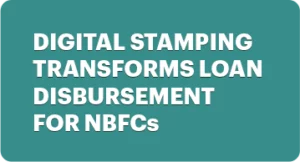Reducing Administrative Overhead: How Online Stamp Duty Payments Boost Business Productivity
Introduction
In the world of modern business, where digital transformation is reshaping operations, it’s essential to reevaluate conventional processes. One such process that businesses often encounter is stamp duty. This blog explores the concept of stamp duty, its significance for businesses, and the imperative shift towards online stamp duty payment methods. We will discuss the legal requirements, types of stamp duty payment, and the compelling reasons to avoid physical stamping. Discover the benefits of eStamping for businesses, learn how to make online stamp duty payments step by step, and explore the advantages of utilizing an estamping platform. Real-world case studies will showcase businesses that have successfully transitioned to digital stamp duty payment. Let’s embark on a journey to modernize and simplify stamp duty processes for businesses.
What is Stamp Duty?
Stamp duty is a financial obligation imposed by governments on various transactions or documents. Its primary purpose is to validate the legality and enforceability of these documents. Businesses frequently encounter stamp duty when dealing with contracts, leases, and property transactions. The amount of stamp duty payable varies based on factors such as the document’s nature and its value.
Why is Stamp Duty Important for Businesses?
Stamp duty holds immense importance for businesses due to several key reasons:
- Convenience: E-stamp certificates can be verified online, eliminating the need for physical visits to government offices. This convenience saves time and effort.
- Legal Validity: Payment of stamp duty is crucial for documents to hold legal validity. Without it, agreements may not be enforceable, potentially leading to disputes.
- Financial Planning: Businesses must factor in stamp duty expenses when planning budgets and finances. Ignoring these costs can lead to unexpected financial burdens.
What Are the Legal Requirements for Stamp Duty?
Stamp duty requirements differ from one jurisdiction to another. These requirements generally include:
- Document Types: Stamp duty applies to various document types, such as property deeds, lease agreements, insurance policies, and more.
- Stamp Duty Rates: Rates are determined based on the document’s nature and value. Different regions may have varying rates.
- Stamping Process: Traditionally, the stamping process involves purchasing adhesive stamps from authorized vendors and physically affixing them to documents.
Types of Stamp Duty Payment
Historically, businesses have had two primary methods of fulfilling their stamp duty obligations:
1. Physical Stamping
This conventional method involves physically purchasing adhesive stamps and manually affixing them to documents. While it has been the standard practice for years, it poses several challenges for businesses.
2. Estamping
Estamping represents a more modern approach where stamp duty is paid electronically through government-approved digital platforms. This method offers a streamlined and efficient way to fulfill stamp duty obligations.
5 Reasons Why You Should Avoid Physical Stamping
While physical stamping has been the norm for many years, businesses should consider transitioning to digital stamping and online payment methods for the following compelling reasons:
- Administrative Burden: Physical stamping involves manual paperwork, the purchase of stamps, and affixing them to documents, consuming valuable time and resources.
- Error-Prone: Manual processes are susceptible to human errors, such as miscalculations or misapplication of stamps, potentially leading to legal issues.
- Inefficiency: Traditional stamping requires physical presence, causing inconvenience and potential delays, especially in times of remote work or travel restrictions.
- Costs and Overheads: Businesses incur costs related to purchasing stamps, transportation, and storage of physical stamping supplies.
- Risk of Non-Compliance: With the complexity of stamp duty regulations, businesses face risks of unintentional non-compliance, leading to legal and financial repercussions.
Benefits of eStamping for Businesses
Embracing online stamp duty payment methods, also known as eStamping, offers businesses a plethora of compelling benefits:
-
Convenience and Ease of Use
eStamping platforms empower businesses to complete stamping processes conveniently from anywhere, eliminating the need for physical visits to government offices. -
Increased Efficiency and Productivity
Automation streamlines the stamping process, allowing employees to allocate their time and resources to more critical tasks, ultimately boosting productivity. -
Reduced Costs
eStamping eliminates the need for physical stamps, storage, and transportation costs, resulting in significant savings for businesses. -
Enhanced Security and Compliance
Online platforms prioritize data security, often using encryption and adhering to industry standards. This ensures the protection of sensitive financial information and compliance with tax regulations, giving businesses peace of mind.
How to Pay Stamp Duty Online for Businesses
Transitioning to online stamp duty payment methods is straightforward. Here’s a step-by-step guide to help businesses navigate the process:
-
Step 1: Determine Stamp Duty Liability
Before initiating payment, accurately calculate the stamp duty amount owed based on the document type and its value. This information is typically available on government websites or can be obtained from tax authorities. -
Step 2: Choose an eStamping Platform
Select a reputable online stamp duty payment platform that aligns with your business needs and ensures compliance with relevant regulations. Ensure that the platform offers the required payment methods. -
Step 3: Document Upload
Upload the document that requires stamping onto the platform. The system will automatically assess the stamp duty liability based on the document’s details. -
Step 4: Payment
Proceed to make the payment using your preferred method, such as credit/debit card, bank transfer, or electronic wallet. Double-check the payment details for accuracy. -
Step 5: Confirmation
Once the payment is successful, the platform will generate a digitally stamped document as proof of payment. This document should be retained for future reference, serving as legal evidence.
Benefits of Using an eStamping Platform
Utilizing an eStamping platform goes beyond convenience; it offers several key advantages for businesses:
-
Convenience and Ease of Use
Before initiating payment, accurately calculate the stamp duty amount owed based on the document type and its value. This information is typically available on government websites or can be obtained from tax authorities. -
Increased Efficiency and Productivity
Automation streamlines the stamping process, allowing employees to allocate their time and resources to more critical tasks, ultimately boosting productivity. -
Reduced Costs
eStamping eliminates the need for physical stamps, storage, and transportation costs, resulting in significant savings. -
Enhanced Security and Compliance
Online platforms prioritize data security, often using encryption and adhering to security standards. This ensures data protection and compliance with tax regulations, giving businesses peace of mind.
Enable Easy Stamp Procurement With Real-Time eStamping with MSB Docs
Estamp procurement with real-time eStamping solution by MSB Docs is a game-changer for businesses seeking a streamlined and efficient approach to fulfill their stamp duty obligations. MSB Docs offers a cutting-edge solution that revolutionizes the way businesses manage stamping processes.
With MSB Docs’ real-time eStamping, businesses can:
- Save Time: Say goodbye to the time-consuming process of physically affixing stamps. MSB Docs allows for instant stamping, reducing document processing time significantly.
- Ensure Accuracy: Automated calculations ensure accurate stamp duty assessment, eliminating the risk of errors associated with manual calculations.
- Enhance Security: MSB Docs prioritizes data security, implementing robust encryption and compliance measures to safeguard sensitive financial information.
- Achieve Compliance: Stay up-to-date with changing stamp duty regulations effortlessly. MSB Docs adapts to the latest legal requirements, ensuring businesses remain compliant.
- Go Paperless: Reduce environmental impact by eliminating the need for physical stamps and paperwork, contributing to a sustainable business practice.
- Convenience: Access the eStamping platform 24/7 from anywhere, allowing businesses to meet their stamp duty obligations at their convenience.
Incorporating MSB Docs’ real-time eStamping into your business processes not only simplifies stamp duty compliance but also enhances efficiency, accuracy, and security. It’s a modern solution for businesses looking to stay ahead in the digital era.If you’re new to E-Stamping and Affidavit creation, start with our comprehensive guide.
Conclusion
Incorporating online stamp duty payment into your business operations can bring about substantial benefits, including increased efficiency, reduced costs, and improved compliance. By leveraging eStamping platforms, businesses can save time and resources while ensuring their stamp duty obligations are met accurately and securely.
If you’re a business owner seeking to streamline your stamp duty payment process and boost operational efficiency, consider embracing online stamp duty payment platforms. Explore the available options and choose a platform that aligns with your specific needs and regulatory requirements. Make the move to modernize your stamp duty payment process today and experience the advantages it offers.
In an increasingly digital world, staying ahead of the curve is essential for businesses to thrive. Online stamp duty payment is a prime example of how embracing technology can simplify processes and drive growth.
Reviewed our guide on the benefits of online stamp duty payments for reducing administrative overhead? Ready to optimize your business operations now? Request a demo or book your free trial with MSB Docs today.
FAQs
1. How do I determine the stamp duty amount for my specific document or transaction?
To calculate your stamp duty liability, you should consider the type of document, its value, and your location, as rates can vary by jurisdiction. Most government websites provide stamp duty calculators or guidelines to help you determine the exact amount. Alternatively, you can consult with local tax authorities or seek assistance from professional advisors.
2. Can I use any digital platform for online stamp duty payment, or are there government-approved platforms I must use?
Many governments have approved specific digital platforms for online stamp duty payments to ensure compliance and security. It’s advisable to use government-approved platforms, as they typically adhere to the latest regulations and offer secure transactions. Check with your local tax authority for a list of approved platforms in your area.
3. Are there any stamp duty exemptions or discounts available for businesses?
Yes, some jurisdictions offer stamp duty exemptions or discounts to certain types of businesses or transactions. These exemptions or discounts may apply to small businesses, first-time homebuyers, or specific types of contracts. It’s essential to research your local regulations or consult with tax experts to determine if your business qualifies for any such benefits.
4. What should I do if I suspect a fraudulent e-stamp certificate?
If you’ve made an error in your online stamp duty payment, it’s crucial to rectify it promptly. Contact the relevant tax authority or the platform’s customer support for guidance on how to correct the mistake. Delaying action could result in penalties or compliance issues, so address the error as soon as possible.
5. Is online stamp duty payment secure, and how is my financial information protected?
Online stamp duty payment platforms prioritize data security. They typically employ encryption protocols to protect your financial information during transactions. Additionally, these platforms often adhere to industry security standards and undergo regular audits to ensure compliance. While no system is entirely risk-free, using government-approved online platforms provides an added layer of security for your transactions.





